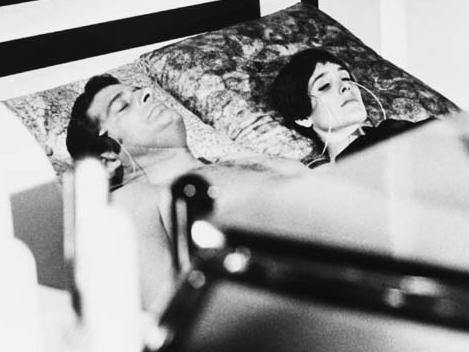
(Robert Dix with Eleanor Parker in "Interrupted Melody")
Robert Dix Interview:
Recollections of Al Adamson
This page was last updated on 09/19/03 12:37 AM
(NOTE: Interview with Robert Dix conducted by Tom Weaver,
appeared originally in CLASSIC IMAGES.
DO NOT use or reproduce this interview without permission!)
Tom Weaver: Here's what he told me about Adamson/his Adamson movies. We were talking about a movie of his called LAS VEGAS STRANGLER, where he played the title role, and then we segued into Adamson............

(Robert Dix with Eleanor Parker in "Interrupted Melody")
Q: Las Vegas Strangler was the first time you played a nut; I guess the second time might be Blood of Dracula’s Castle where you played "The Moon Maniac."
A: Exactly. A very similar type of mental illness!
Q:
Did you enjoy playing psychos?
A:
Well, let’s say it was a departure from anything I had done before. Before that, when I had been cast in movies and TV, pretty much the only characterization I would have would be, like, a Union officer in the Army, or maybe play an Indian-with-a-wig-on kind of thing. But when you actually have to develop the inner life of a character who was nuts, that was an interesting challenge. In both cases, I recall, it came off pretty believably—I had people comment in the positive regarding it. It was a stretch for me, and in the final analysis it was good experience. What I remember about Dracula’s Castle was that it was the first time I had the opportunity to work with John Carradine. I really loved that old man. He was a great guy. I gotta tell you a story that he told me, a story I’m sure a lot of people have never heard: When Mr. Carradine first came to Hollywood, there were rumors going around that he must be a vampire or something [laughs], 'cause he only came out at night. And he told me the reason he only came out at night was, the only wardrobe he had was a tuxedo! Since that was the only clothes he had, he had to stay inside during the daytime!
John and I became quite close, we worked in several movies together. He could recite Shakespeare 'til the cows came home [laughs], and he had a heart as big as outdoors. But unfortunately he’d been married a number of times, his wives were all after him for alimony, and he always had to get paid cash under the table so he’d have some walkin’ around money.
As I say, my first experience with John was in Dracula’s Castle. I remember that this was the first time because I was a fan of his, and I really respected the man’s talent. We did a scene around a pool table where we had to shoot pool and deliver lines back and forth about the moon drivin’ people nuts—my character in particular! I remember being—well, not nervous, but kind of on edge, since I was working with The Master. But he made me feel so comfortable, and was so generous with his knowledge and his time.
Q:
Where was Dracula’s Castle shot?
A:
The castle was out in the High Desert country, between L.A. and Victorville somewhere. It was an isolated old structure. There was no ocean near that castle, though in the movie it was made to look so.
Q:
How about the actors playing Mr. and Mrs. Dracula in that movie, Alex D’Arcy and Paula Raymond?
A:
I really loved both of them. "The beauty of the Old Hollywood": These were professional performers who were a real joy to be around. Talk about anecdotes: Just having coffee on the set, they could tell you stories 'til the cows come home about their careers. Paula Raymond was a leading lady [in the ’40s and ’50s] and then had a severe automobile accident, and her whole face had to be restructured. She really was a fine person, a wonderful, talented actress and, really, I had the greatest admiration for her courage to come back after that very severe accident. She became one of my favorite people, as did Alex D’Arcy.
Q:
Once you get down to the level of movies like Blood of Dracula’s Castle, what about the stuntwork? Does the actor end up doing a lot of his own?
A:
That was all me on Dracula’s Castle. On the independents, you don’t have doubles or stand-ins or anything like that, you do all the work yourself. I was fortunate to be trained by Jock Mahoney as a young actor. Jock taught us how to choreograph a fight and tuck and roll when you fall. A lot of movies that I worked in in the late ’50s and into the ’60s which required physical activity, I did all the work myself. There were a few exceptions, but only when the director said, "I don’t want you to get hurt. We’re putting a stuntman in there." It helped me to get a lot of roles, being able to ride a horse, to take a fall, to stage a fight, to take a punch. I could do all that stuff. A lot of actors—as we used to call 'em, the "patent leather actors from New York"—didn’t have a clue which end of the horse ate [laughs]!
Q:
Al Adamson has got a bit of a following these days, partly because of the outlandish nature of his movies and partly, I think, because of his well-publicized murder.
A:
Well, I’ll say this about Al, God rest his soul: He was very dedicated to the craft of being a director. But...there weren't that many people that liked Al that much. He was out to make a buck, [to the point where] you better have your hand on your wallet. I don’t like speaking negatively about anybody who’s gone on to the Great Pasture in the Sky, so I’ll just say that Al and I had a working relationship that was beneficial to both of us. But I’ll also say that it’s good to know somebody’s qualities, so you can keep an eye on 'em [laughs]! When he was murdered, there were a lot of people who said he had it comin’. 'Cause, frankly, you had to work for Al twice: Once when you did your job, whatever you were doing, acting, sound or whatever...and the second time was to get your paycheck. I on several occasions, representing both cast and crew, would have to hunt him down and get those people’s money. That’s the reputation he developed.
Q:
A lot of Adamson’s movies aren’t any good. Is that because he didn’t have enough time and money, or because he didn’t have enough talent?
A:
I think it’s more in the taste and talent department [laughs]! If the work of an independent producer-director has some inspiration and quality, investors come out of the woodwork—they’ll come in and help an independent company. Well, Al never had that happen, not to my knowledge. Because he didn’t want to treat people correctly. Including the money people! Every time he wanted to start something new, he’d pretty much have to go out and get a whole new group of folks to hornswoggle into doin’ something. He made a rod for his own back, I’ll put it that way.
Q:
If he wasn’t busting at the seams in the Taste and Talent Department, or even in the Honesty Department, why did Dix International Pictures hire him to product and direct Five Bloody Graves?
A:
Al had a friend who put some seed money in—he matched the seed money that we’d put in. But with the condition that Al direct.

Q:
Five Bloody Graves—which you also wrote—was partially based on the life of a real-life gunfighter, correct?
A:
Yes it was. I wanted to do a commercial piece, but I wanted to also base it on true American history. So it was modeled after a little-known gunfighter called Ben Thompson. Thompson was a very interesting guy. It didn’t come out in the movie that he was in love with his first cousin, she jilted him and married another guy, and he went West with a death wish. When he was 33 years old, he drank a bottle of booze and blew his brains out. But he was a very, very lethal gunfighter because he didn’t give a damn. He had such contempt for one challenger that he showed up on the main street of the town naked, with nothin’ on except a six-gun. And shot the guy! Of course, that didn’t’ come out in the movie in the ’60s. You might be able to do it today [laughs]! The major portion of Five Bloody Graves was made in a place called Fruita, Utah. It’s a lodge with one gas pump, up near Goblin Valley. The people on that picture, both cast and crew, were a really good bunch. Scott Brady and Jim Davis was old pals, a lot of fun to be around.
Q:
I found a New York Times review of Five Bloody Graves and a quote that I thought was funny but you probably won’t: "Its sole virtue is that everybody in it gets knocked off, with one inexcusable exception, the guy who wrote it."
A:
[Laughs] That’s good, yeah! But, I have to say...not making excuses for the writer, after the transition from the page to the screen, it was hardly recognizable as having come from my original screenplay. This was due to the Adamson direction and subsequent post-production work. The original screenplay and what ended up on the screen were very, very different.
Q:
Whose idea was it to have the movie narrated by Death (played by Gene Raymond)?
A:
That was Adamson. I never had that in there. After the way Adamson [made the movie], there were so many holes in it that it needed a narration track to explain what the heck was goin’ on [laughs]!
Q:
You said that on Deadwood ’76 it was interesting to watch father-and-son Arch Halls working together. Did you feel the same way watching Al Adamson and his actor-father working on Five Bloody Graves?
A:
Yes, and in fact, I enjoyed Al’s very much. Denver Dixon was a very interesting character who dated back to the early days of Hollywood. I liked ol’ Denver. I didn’t feel the closeness between father and son there, but I wasn’t around 'em that much.
Q:
Al Adamson’s partner Sam Sherman—what memories of him?
A:
Sam and I have always gotten along okay. It’s been pretty much a long-distance thing, over the phone; first just business, and then I did visit him one time in New York and saw the Independent International operation there. Sam and I have had a friendly relationship through the years, and still remain friends. Sam is the one guy who always defended Al Adamson one way or another. It wasn’t an easy job, but Sam remained his partner and his friend through the years.
Q:
Did Sam have blinders on when it came to Adamson’s bad qualities?
A:
[Laughs] I just would say that he was inventive in justifying Al’s behavior!
Q:
You had a small part, but great billing, in Adamson’s Horror of the Blood Monsters.
A:
Many times when I worked in these Adamson movies, I didn’t know what they were going to be titled. We’d get called to do a scene, some little sequence that might be inserted in something that was untitled at the time. So we didn’t even know what name the picture was gonna be released under. This was one of those deals: I simply went by the studio and learned my lines and I played a colonel, sitting at a control instrument panel kind of thing. I never saw any finished product, though I heard later of course that it became part of one of his space movies [Blood Monsters]. That’s all I remember about that particular shoot: just going on the sound stage, doing my thing (which I usually did in one take) and "Goodbye."

Q:
You must also remember an actress named Vicki Volante who was in the scenes with you—and you have a scene in bed with her!
A:
Vicki, she was a sweetheart. On Five Bloody Graves, Al Adamson fell in love with Vicki Volante up in the mountains of Utah, and was pursuing her for quite a few months after that. That’s probably where there were editorial problems on that picture: His mind was elsewhere [laughs]!

Q:
Did he ever catch her?
A:
Naw, she had a boyfriend and got married and had babies. Another actress, Regina Carrol, finally came along and put up with Al’s jazz and married him, and I guess Al had a pretty decent relationship with her for many years until she passed on. But, getting back to your question, I do recall the sex scene with Vicki Volante that you speak of. It’s hard to have a sex scene with a bunch of people in the crew standing around. It’s something I think of often when I see these intimate sex scenes in movies these days—I think to myself, "If the audience could just see how many people are standin’ around that bed, it would take a lot of the pizzazz out of it!"

Dix in Al Adamson's Satan's Sadists

Dix in Frankenstein's Daughter

Dix in Forbidden Planet,
questioned by the captain (Leslie Nielsen)
and confronting the Monster from the Id
